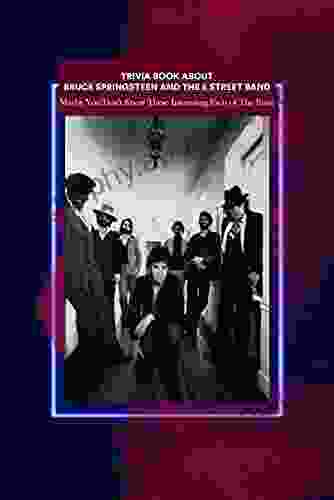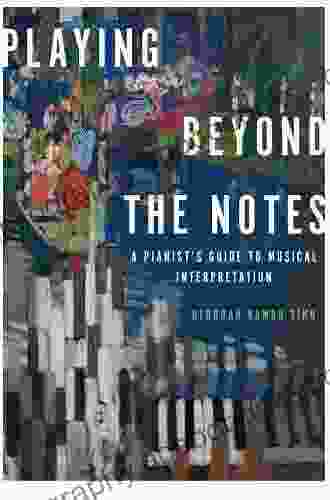The Pianist's Guide to Musical Interpretation: Unlocking the Secrets of Performance

As a pianist, your goal is not just to play the notes correctly but to convey the emotions and ideas behind the music. Musical interpretation is the art of bringing your own unique perspective to a piece, making it your own and sharing it with the world.
4.9 out of 5
| Language | : | English |
| File size | : | 11602 KB |
| Text-to-Speech | : | Enabled |
| Enhanced typesetting | : | Enabled |
| Word Wise | : | Enabled |
| Print length | : | 158 pages |
| Lending | : | Enabled |
| Screen Reader | : | Supported |
| Paperback | : | 64 pages |
| Item Weight | : | 7.8 ounces |
| Dimensions | : | 8.5 x 0.16 x 11 inches |
But how do you interpret music effectively? What are the techniques and insights that can help you unlock the secrets of performance?
In this comprehensive guide, we will explore everything you need to know about musical interpretation. We will cover the following topics and more:
- The different elements of musical interpretation
- How to analyze a piece of music
- How to develop your own interpretation
- How to communicate your interpretation to an audience
Whether you are a beginner or an experienced pianist, this guide will help you take your performances to the next level. So sit back, relax, and let us begin our journey into the world of musical interpretation.
Chapter 1: The Elements of Musical Interpretation
Before we can discuss how to interpret music, we need to understand the different elements that make up a musical performance.
These elements include:
- Tempo: The speed at which a piece of music is played.
- Rhythm: The pattern of beats and accents in a piece of music.
- Dynamics: The volume and intensity of a piece of music.
- Articulation: The way in which notes are played, including the use of staccato, legato, and other techniques.
- Phrasing: The grouping of notes into meaningful phrases.
All of these elements work together to create the overall interpretation of a piece of music. By understanding how each element affects the sound and meaning of the music, you can begin to develop your own unique interpretation.
Chapter 2: Analyzing a Piece of Music
The first step to interpreting a piece of music is to analyze it carefully. This involves studying the following aspects of the piece:
- The form: The overall structure of the piece, including the number and Free Download of movements.
- The harmony: The chords that make up the piece.
- The melody: The main tune of the piece.
- The texture: The number and types of instruments that are used.
By analyzing a piece of music, you can gain a deeper understanding of its structure and meaning. This understanding will help you to make informed decisions about how to interpret the piece.
Chapter 3: Developing Your Own Interpretation
Once you have analyzed a piece of music, you can begin to develop your own interpretation. This is a creative process that involves using your own musical instincts and imagination.
There are no right or wrong interpretations of music. The best interpretation is the one that is most true to your own musical personality.
Here are a few tips for developing your own interpretation:
- Listen to the music carefully: Pay attention to the different elements of the music, such as the tempo, rhythm, and dynamics.
- Think about the meaning of the music: What is the composer trying to say with this piece? What emotions does it evoke in you?
- Experiment with different interpretations: Try playing the piece at different tempos, with different dynamics, and with different articulations. See what sounds best to you.
Don't be afraid to make mistakes. The more you experiment, the better you will become at developing your own unique interpretations.
Chapter 4: Communicating Your Interpretation to an Audience
Once you have developed your own interpretation of a piece of music, you need to be able to communicate it to an audience. This involves using your body language, facial expressions, and playing technique to convey the emotions and ideas behind the music.
Here are a few tips for communicating your interpretation to an audience:
- Be confident: Believe in your interpretation and don't be afraid to show it.
- Make eye contact with the audience: This will help you to connect with them on a personal level.
- Use your body language to express the music: Move your body with the music and use your facial expressions to convey the emotions of the piece.
- Play with conviction: Your audience will be able to tell if you are passionate about the music you are playing.
By communicating your interpretation to an audience, you can create a powerful and memorable performance.
Musical interpretation is a complex and rewarding art form. By understanding the different elements of musical interpretation, analyzing pieces of music, developing your own interpretations, and communicating them to an audience, you can take your performances to the next level and connect with audiences on a deeper level.
So what are you waiting for? Start exploring the world of musical interpretation today!
4.9 out of 5
| Language | : | English |
| File size | : | 11602 KB |
| Text-to-Speech | : | Enabled |
| Enhanced typesetting | : | Enabled |
| Word Wise | : | Enabled |
| Print length | : | 158 pages |
| Lending | : | Enabled |
| Screen Reader | : | Supported |
| Paperback | : | 64 pages |
| Item Weight | : | 7.8 ounces |
| Dimensions | : | 8.5 x 0.16 x 11 inches |
Do you want to contribute by writing guest posts on this blog?
Please contact us and send us a resume of previous articles that you have written.
 Book
Book Novel
Novel Page
Page Chapter
Chapter Text
Text Story
Story Genre
Genre Reader
Reader Library
Library Paperback
Paperback E-book
E-book Magazine
Magazine Newspaper
Newspaper Paragraph
Paragraph Sentence
Sentence Bookmark
Bookmark Shelf
Shelf Glossary
Glossary Bibliography
Bibliography Foreword
Foreword Preface
Preface Synopsis
Synopsis Annotation
Annotation Footnote
Footnote Manuscript
Manuscript Scroll
Scroll Codex
Codex Tome
Tome Bestseller
Bestseller Classics
Classics Library card
Library card Narrative
Narrative Biography
Biography Autobiography
Autobiography Memoir
Memoir Reference
Reference Encyclopedia
Encyclopedia Akinyele Omowale Umoja
Akinyele Omowale Umoja Richard D Mahoney
Richard D Mahoney John Brenkman
John Brenkman M B Henry
M B Henry Hanoch Levin
Hanoch Levin Neil Hack
Neil Hack George A Mashour
George A Mashour Erzabet Bishop
Erzabet Bishop Freek Berson
Freek Berson Marilee David
Marilee David Pamela Young
Pamela Young Doug Gelbert
Doug Gelbert Victoria Connelly
Victoria Connelly Vijay Prashad
Vijay Prashad Yoichi Arakawa
Yoichi Arakawa Michael Healey
Michael Healey Tor Wo Chiu
Tor Wo Chiu Patricia Haesly Worthington
Patricia Haesly Worthington Michele Trapani
Michele Trapani Garth Stein
Garth Stein
Light bulbAdvertise smarter! Our strategic ad space ensures maximum exposure. Reserve your spot today!

 Aldous HuxleyServant Leadership Developments in Theory and Research: A Comprehensive Guide
Aldous HuxleyServant Leadership Developments in Theory and Research: A Comprehensive Guide
 Forrest ReedAn Action-Packed Historical Military Adventure: Marcus Baxter Naval Thrillers
Forrest ReedAn Action-Packed Historical Military Adventure: Marcus Baxter Naval Thrillers Raymond ChandlerFollow ·8.5k
Raymond ChandlerFollow ·8.5k Kurt VonnegutFollow ·19.2k
Kurt VonnegutFollow ·19.2k Terry BellFollow ·8k
Terry BellFollow ·8k Robbie CarterFollow ·15.2k
Robbie CarterFollow ·15.2k Reginald CoxFollow ·2.5k
Reginald CoxFollow ·2.5k Levi PowellFollow ·3.1k
Levi PowellFollow ·3.1k Jorge AmadoFollow ·18.1k
Jorge AmadoFollow ·18.1k Harvey BellFollow ·4.9k
Harvey BellFollow ·4.9k

 Finn Cox
Finn CoxEmpowering School-Based Professionals: A Comprehensive...
: The Role of School-Based Professionals in...

 F. Scott Fitzgerald
F. Scott FitzgeraldThe Santa Fe Trail Twentieth Century Excursion: A...
Get ready to embark on an...

 Kendall Ward
Kendall WardThe Ultimate Trivia Guide to Bruce Springsteen and the...
Bruce Springsteen...

 Jedidiah Hayes
Jedidiah HayesThe Trouble with Lacy Brown: Texas Matchmakers - A...
Prepare to be swept...
4.9 out of 5
| Language | : | English |
| File size | : | 11602 KB |
| Text-to-Speech | : | Enabled |
| Enhanced typesetting | : | Enabled |
| Word Wise | : | Enabled |
| Print length | : | 158 pages |
| Lending | : | Enabled |
| Screen Reader | : | Supported |
| Paperback | : | 64 pages |
| Item Weight | : | 7.8 ounces |
| Dimensions | : | 8.5 x 0.16 x 11 inches |












